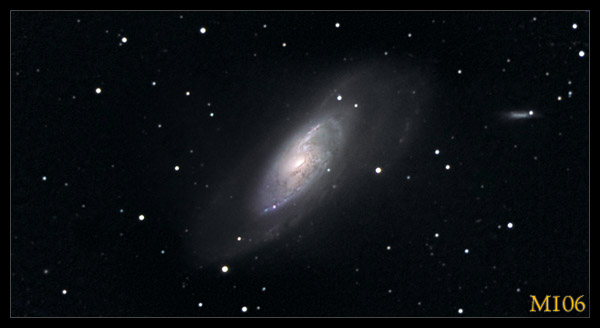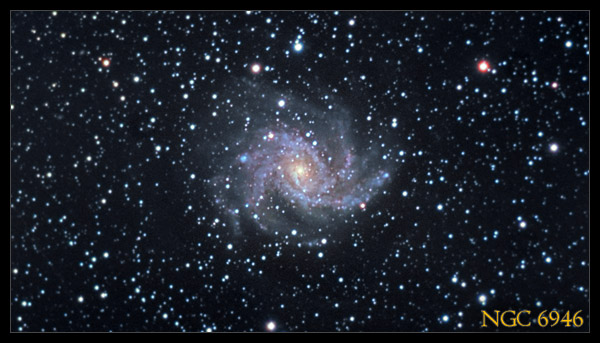|
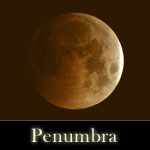
|
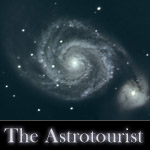
|
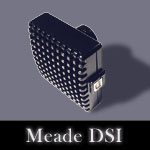
|
Astronomical image manipulation software |
Touring the Universe and returning with pictures
|
Tips & tricks for the Meade Deep Sky Imager
|
Astrophotography Blog
|
10/1/2010 |
| object | type | location | mag | size | skill |
|---|
| NGC 7293 Helix Nebula | pn | Aqr 22H 29.64m -20°50.22' | 6 | 12' × 10' | Beginner |
| NGC 7331 | sg | Peg 22H 37.1m +34°25' | 9.5 | 9.7' × 4.5' | Intermediate |
| NGC 7479 | sg | Peg 23H 5m +12°19' | 10.8 | 3.9' × 3' | Intermediate |
| NGC 7606 | sg | Aqr 23H 19.1m -8°29' | 10.8 | 5.8' | Intermediate |
| NGC 7635 Bubble Nebula | dn | Cas 23H 20.7m +61°12' | 10 | 15' × 8' | Intermediate |
| Arp 319 Stephan's Quintet | cg | Peg 22H 36m +33°57.9' | 13.6 | 11' × 8.5' | Advanced |
| NGC 7662 | pn | And 23H 23.9m +42°32.1' | 8.3 | 0.5' × 0.5' | Advanced |
| Sh2-142 | dn | Cep 22H 47.3m +58°8' | 10 | 30' × 30' | Advanced |
| Sh2-155 Cave Nebula | dn | Cep 22H 56.8m +62°37' | 10 | 50' × 30' | Advanced |
Like a bag of trick-or-treat candy, October holds a multicolor variety of sweet targets: pale blue galaxies, red and teal planetaries, and deep red nebulae.
More... |
|
9/1/2010 |
| object | type | location | mag | size | skill |
|---|
| IC 5146 Cocoon Nebula | dn | Cyg 21H 53.4m +47°16' | 9.3 | 10' × 10' | Intermediate |
| NGC 6888 Crescent Nebula | dn | Cyg 20H 12m +38°21' | 8.8 | 18' × 13' | Intermediate |
| NGC 6946 | sg | Cep 20H 34.9m +60°9' | 8.8 | 11.2' × 8.8' | Intermediate |
| NGC 6960 Western Veil Nebula | sn | Cyg 20H 45.7m +30°43' | 7.9 | 70' × 6' | Intermediate |
| NGC 6992 Eastern Veil Nebula | sn | Cyg 20H 56.4m +31°43' | 7.5 | 60' × 8' | Intermediate |
| NGC 7000 North America Nebula | dn | Cyg 20H 58.8m +44°20' | 3.8 | 100' × 60' | Intermediate |
| NGC 7008 | pn | Cyg 21H 0.55m +54°32.58' | 9.9 | 1.6' × 1.3' | Intermediate |
| NGC 7009 | pn | Aqr 21H 4.18m -11°21.82' | 8 | 0.7' × 0.4' | Intermediate |
| NGC 7023 Iris Nebula | dn | Cep 21H 1.6m +68°10' | 7.7 | 10' × 8' | Intermediate |
| NGC 7129 | dn | Cep 21H 41.3m +66°6' | 11.5 | 7' × 7' | Intermediate |
| IC 1396 Elephant Trunk Nebula | dn | Cep 21H 39.1m +57°30' | | 180' × 180' | Advanced |
| IC 5067 Pelican Nebula | dn | Cyg 20H 50.8m +44°21' | | 60' × 60' | Advanced |
| NGC 7027 | pn | Cyg 21H 7.03m +42°14.17' | 8.5 | 0.3' × 0.2' | Advanced |
The reign of the nebula continues in September, but the bright objects of Sagittarius give way to the fainter and subtler clouds of Cygnus.
Read more...
|
|
8/1/2010 |
| object | type | location | mag | size | skill |
|---|
| M8 Lagoon Nebula | dn | Sgr 18H 3.8m -24°23' | 6 | 90' × 40' | Beginner |
| M16 Eagle Nebula | dn | Ser 18H 18.8m -13°47' | 6.4 | 7' | Beginner |
| M17 | dn | Sgr 18H 20.8m -16°11' | 7 | 11' | Beginner |
| M20 Trifid Nebula | dn | Sgr 18H 2.6m -23°2' | 9 | 28' | Beginner |
| M27 Dumbbell Nebula | pn | Vul 19H 59.6m +22°43' | 7.4 | 8' × 5.7' | Beginner |
| M57 Ring Nebula | pn | Lyr 18H 53.6m +33°2' | 8.8 | 1.4' × 1' | Beginner |
| M24 Sagittarius Star Cloud | mw | Sgr 18H 16.9m -18°29' | 4.6 | 90' | Intermediate |
| NGC 6572 | pn | Oph 18H 12.1m +6°51' | 9 | 0.1' | Advanced |
| NGC 6781 | pn | Aql 19H 18.5m +6°32' | 11.8 | 1.9' × 1.8' | Advanced |
| NGC 6818 | pn | Sgr 19H 43.96m -14°9.18' | 9.3 | 0.4' × 0.3' | Advanced |
| NGC 6826 | pn | Cyg 19H 44.8m +50°31.5' | 8.5 | 0.5' × 0.4' | Advanced |
If you ever wanted to be an astrophotographer, August is the perfect month to start. In the Northern Hemisphere, August nights are warm and generally clear, at least in many parts of the Western United States. More importantly, August has more beginner-level objects than any other month of the year.
Read more... |
M63 |
7/15/2010 |
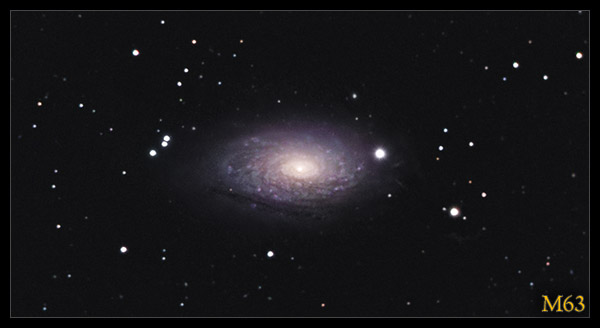
M63 is one of the first galaxies I ever captured. Now, with better equipment and some more experience I visit the Sunflower Galaxy again.
The Astrotourist: M63 |
|
7/1/2010 |
| object | type | location | mag | size | skill |
|---|
| M13 Great Hercules Cluster | gc | Her 16H 41.7m +36°28' | 5.8 | 16.6' | Beginner |
| Abell 2151 Hercules Galaxy Cluster | cg | Her 16H 5.3m +17°45' | - | | Intermediate |
| IC 4604 Rho Ophiuchus Nebula | dn | Oph 16H 25.5m -23°27' | | | Intermediate |
| NGC 6369 | pn | Oph 17H 29.35m -23°45.58' | 11.4 | 1' × 0.6' | Advanced |
| NGC 6384 | sg | Oph 17H 32.4m +7°4' | 10.6 | 6' | Advanced |
| NGC 6503 | sg | Dra 17H 49.4m +70°9' | 10.2 | 6.2' | Advanced | | NGC 6543 Cat's Eye Nebula | pn | Dra 17H 58.56m +66°37.98' | 8.1 | 0.4' × 0.3' | Advanced |
July's most famous jewel is the Great Hercules Cluster, also known as M13.
Read more... |
|
6/1/2010 |
| object | type | location | mag | size | skill |
|---|
| M101 | sg | UMa 14H 3.2m +54°21' | 7.9 | 28.8' × 26.9' | Intermediate |
| NGC 5746 | sg | Vir 14H 44.9m +1°57' | 9.3 | 8.1' × 1.4' | Intermediate |
| NGC 5866 | lg | Dra 15H 6.5m +55°46' | 9.9 | 6.5' × 3.1' | Intermediate |
| Arp 271 | pg | Vir 14H 3.42m -6°3' | 12 | 5.5' | Advanced |
| Arp 286 | sg | Vir 14H 20.25m +3°57' | 11.5 | 11' | Advanced |
| Arp 297 | sg | Boö 14H 45.17m +38°45' | 14.5 | 11' | Advanced |
| NGC 5529 | sg | Boö 14H 15.6m +36°13' | 13 | 5.9' × 1' | Advanced |
| NGC 5775 | sg | Vir 14H 54m +3°33' | 11.4 | 4.3' | Advanced |
| NGC 5850 | sg | Vir 15H 7.1m +1°33' | 11 | 4.3' × 3.9' | Advanced |
| NGC 5907 | sg | Dra 15H 15.9m +56°19' | 10.4 | 12.3' × 1' | Advanced |
| NGC 5921 | sg | Ser 15H 21.9m +5°4' | 10.8 | 4.9' | Advanced |
| NGC 5982 Draco Group | cg | Dra 15H 38.7m +59°21' | | | Advanced |
| NGC 6015 | sg | Dra 15H 51.4m +62°19' | 11.2 | 5.4' | Advanced |
The month of May got all the good ones, but June still has some beautiful galaxies, including gigantic M101.
Read more... |
NGC 4216 |
5/15/2010 |
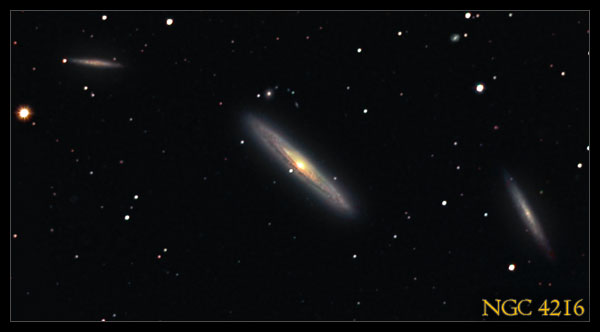
Beautiful NGC 4216 is flanked by two smaller companions: NGC 4222 (left) and NGC 4206 (right).
The Astrotourist: NGC 4216 |
|
5/1/2010 |
| object | type | location | mag | size | skill |
|---|
| M51 Whirlpool Galaxy | sg | CVn 13H 29.9m +47°12' | 8.4 | 11' × 7' | Beginner |
| NGC 4565 | sg | Com 12H 36.3m +25°59' | 9.6 | 16.2' × 2.3' | Beginner |
| M63 Sunflower Galaxy | sg | CVn 13H 15.8m +42°2' | 8.6 | 10' × 6' | Intermediate |
| M64 Black-Eye Galaxy | sg | Com 12H 56.7m +21°41' | 8.5 | 9.3' × 5.4' | Intermediate |
| M83 | sg | Hya 13H 37m -29°52' | 7.6 | 11' × 10' | Intermediate |
| M87 | eg | Vir 12H 30.8m +12°24' | 8.6 | 8.3' × 6.6' | Intermediate |
| M94 | sg | CVn 12H 50.9m +41°7' | 8.2 | 7' × 3' | Intermediate |
| M104 Sombrero Galaxy | sg | Vir 12H 40m -11°37' | 8 | 9' × 4' | Intermediate |
| M106 | sg | CVn 12H 19m +47°18' | 8.4 | 19' × 8' | Intermediate |
| NGC 4631 Whale Galaxy | sg | CVn 12H 42.1m +32°32' | 9.2 | 14.7' × 3.5' | Intermediate |
| Abell 1656 Coma Galaxy Cluster | cg | Com 12H 59.82m +27°58.83' | | | Intermediate |
| M58 | sg | Vir 12H 37.7m +11°49' | 9.7 | 5.5' × 4.5' | Intermediate |
| M61 | sg | Vir 12H 21.9m +4°28' | 9.7 | 6' × 5.5' | Intermediate |
| M88 | sg | Com 12H 32m +14°25' | 9.6 | 7' × 4' | Intermediate |
| M90 | sg | Vir 12H 36.8m +13°10' | 9.5 | 9.5' × 4.5' | Intermediate |
| M91 | sg | Com 12H 35.4m +14°30' | 10.2 | 5.4' × 4.4' | Intermediate |
| M98 | sg | Com 12H 13.8m +14°54' | 10.1 | 9.5' × 3.2' | Intermediate |
| M99 | sg | Com 12H 18.8m +14°25' | 9.9 | 5.4' × 4.8' | Intermediate |
| M100 | sg | Com 12H 22.9m +15°49' | 9.3 | 7' × 6' | Intermediate |
| NGC 4216 | sg | Vir 12H 15.9m +13°9' | 10 | 7.9' × 1.7' | Intermediate |
| NGC 4236 | sg | Dra 12H 16.7m +69°27.8' | 9.6 | 19.6' × 7.6' | Intermediate |
| NGC 4361 | pn | Crv 12H 24.51m -18°47.08' | 10.2 | 1.9' × 1.9' | Intermediate |
| NGC 4449 | pg | CVn 12H 28.2m +44°6' | 9.6 | 5.4' × 4.2' | Intermediate |
| NGC 4490 | pg | CVn 12H 30.6m +41°39' | 9.5 | 5.6' × 2.8' | Intermediate |
| NGC 4535 | sg | Vir 12H 34.3m +8°12' | 9.8 | 6.8' | Intermediate |
| NGC 4559 | sg | Com 12H 36m +27°58' | 10 | 11.3' × 5' | Intermediate |
| NGC 4725 | sg | Com 12H 50.4m +25°30' | 9.2 | 10.5' × 8.1' | Intermediate |
| NGC 5005 | sg | CVn 13H 10.9m +37°3' | 9.8 | 5.6' × 2.9' | Intermediate |
| Arp 244 The Antennae | pg | Crv 12H 1m -18°51' | 11 | 18' × 6' | Advanced |
| NGC 4030 | sg | Vir 12H 0.4m -1°6' | 12 | 4.3' | Advanced |
| NGC 4244 | sg | CVn 12H 17.5m +37°48' | 10.4 | 15.8' × 1.7' | Advanced |
| NGC 4656 | pg | CVn 12H 44m +32°10' | 10.5 | 18.8' × 3.2' | Advanced |
| NGC 4699 | sg | Vir 12H 49m -8°40' | 9.5 | 3.1' × 2.5' | Advanced |
| NGC 5033 | sg | CVn 13H 13.4m +36°36' | 10.1 | 10.5' | Advanced |
| NGC 5248 | sg | Boö 13H 37.5m +8°53' | 10.3 | 6.1' × 4.6' | Advanced |
| NGC 5364 | sg | Vir 13H 56.2m +5°1' | 10.4 | 7.1' | Advanced |
May is officially recognized by every self-respecting international organization as Galaxy Month. You can see from this giant list of targets that some of the best galaxies are out this month, including M51, NGC 4565, M63, and M104.
Read more... |
NGC 2903 |
3/24/2010 |
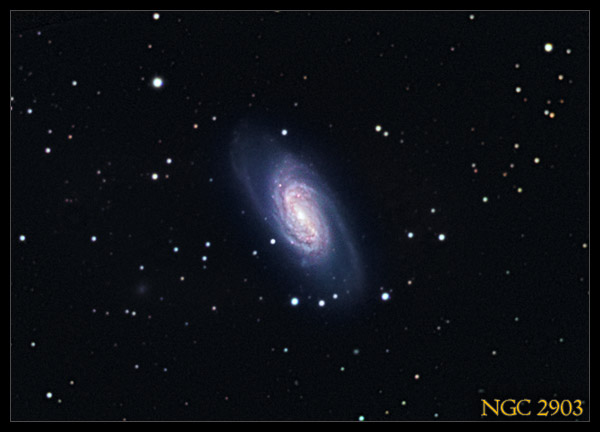
After all the El Niño-spawned clouds this winter it was nice to have some clear nights again. This is an image of NGC 2903, one of the galaxies of Leo.
The Astrotourist: NGC 2903 |
M16 |
6/30/2009 |
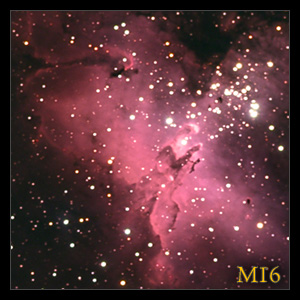 You probably have not heard of the Eagle Nebula (or M16, as it is also known) but you've probably seen the famous Hubble photo of its massive towers of dust and gas: the Pillars of Creation. You probably have not heard of the Eagle Nebula (or M16, as it is also known) but you've probably seen the famous Hubble photo of its massive towers of dust and gas: the Pillars of Creation.
I don't remember where I first saw that image, but I remember thinking how beautiful and amazing it looked. For the first time I could imagine this distant nebula as a real place.
Now I've finally captured that nebula with my own modest equipment. While it does not compare to Hubble's iconic image, it does connect me, in some small way, to that magnificent object.
The Astrotourist: M16 |
|
6/20/2009 |
|
Just because the skies are clear doesn't mean that it will be a good night for astrophotography. Sometimes the skies are turbulent because of winds or temperature changes. On those nights the stars will twinkle ferociously and looking at the sky through a telescope will be like looking at the bottom of a clear lake on a windy day.
Astronomers call that "bad seeing" and it causes the light from distant stars to flicker and jump. Needless to say this distorts astronomical images, leaving them blurry and wavy.
The image on the left is a shot of the galaxy M101 under good seeing conditions. The one on the right shows the same galaxy, taken with the same equipment, on a night of poor seeing.
|
|
4/8/2009 |
| object | type | location | mag | size | skill |
|---|
| M65 | sg | Leo 11H 18.9m +13°5' | 9.3 | 8' × 1.5' | Beginner |
| M66 | sg | Leo 11H 20.2m +12°59' | 8.9 | 8' × 2.5' | Beginner |
| M95 | sg | Leo 10H 44m +11°42' | 9.7 | 4.4' × 3.3' | Intermediate |
| M96 | sg | Leo 10H 46.8m +11°49' | 9.2 | 6' × 4' | Intermediate |
| M97 Owl Nebula | pn | UMa 11H 14.8m +55°1' | 9.9 | 3.4' × 3.3' | Intermediate |
| M108 | sg | UMa 11H 11.5m +55°40' | 10 | 8' × 1' | Intermediate |
| M109 | sg | UMa 11H 57.6m +53°23' | 9.8 | 7' × 4' | Intermediate |
| NGC 3115 The Spindle | lg | Sex 10H 5.2m -7°43' | 8.9 | 6.9' × 3.4' | Intermediate |
| NGC 3242 Ghost of Jupiter | pn | Hya 10H 24.77m -18°38.55' | 7.3 | 45" × 36" | Intermediate |
| NGC 3344 | sg | LMi 10H 43.5m +24°55' | 9.3 | 6.7' × 6.3' | Intermediate |
| NGC 3521 | sg | Leo 11H 5.8m -0°2' | 9.1 | 11.7' × 6.5' | Intermediate |
| NGC 3628 | sg | Leo 11H 20.3m +13°35' | 9.5 | 14.8' × 3.3' | Intermediate |
| NGC 3184 | sg | UMa 10H 18.3m +41°25.4' | 9.8 | 7.4' × 6.9' | Advanced |
| NGC 3338 | sg | Leo 10H 42.1m +13°45' | 10.8 | 5.5' | Advanced | | NGC 3718 | sg | UMa 11H 32.6m +53°4' | 10.5 | 8.7' | Advanced |
| NGC 3938 | sg | UMa 11H 52.8m +44°7' | 10.4 | 5.4' | Advanced |
| NGC 3953 | sg | UMa 11H 53.8m +52°20' | 10.1 | 6.6' | Advanced |
The most popular target in April is the Leo triplet, a grouping of three beautiful spirals: M65, M66, and NGC 3628, but there are other, less famous, galaxies this month that are well worth capturing.
Read more... |
M82 |
3/30/2009 |
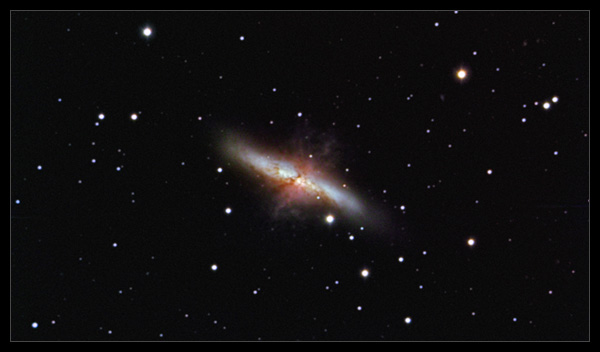
Unravelling the nature of M82 took almost two centuries and required dozens of independent insights from many astronomers. But Johann Bode, the one who first spotted those two faint patches of light and wrote them down in his journal, is the only name commonly associated with M81 and M82. Those other astronomers? I confess I don't even know their names.
The Astrotourist: M82 |
|
3/4/2009 |
March is the beginning of galaxy season!
In its trek around the sun the Earth's nightside sometimes faces the disk of our galaxy. When that happens we see the band of the Milky Way high above us. But as the Milky Way dips towards the horizon, we see what lies beyond our little metropolis of stars—and that means galaxies of all kinds.
| object | type | location | mag | size | skill |
|---|
| M81 Bode's Galaxy | sg | UMa 9H 55.6m +69°04' | 6.9 | 21' × 10' | Beginner |
| M82 | sg | UMa 9H 55.8m +69°41' | 8.4 | 9' × 4' | Beginner |
| NGC 2683 | sg | Lyn 8H 52.7m +33°25' | 10.6 | 9.3' × 2.2' | Intermediate |
| NGC 2841 | sg | UMa 9H 22.0m +50°58' | 9.3 | 8.1' | Intermediate |
| NGC 2903 | sg | Leo 9H 32.2m +21°30' | 8.9 | 12.6' × 6.6' | Intermediate |
| Arp 245 | sg | Hya 9H 45.7m -14°20' | 11.9 | 4.1' | Advanced | | NGC 2613 | sg | Pyx 8H 33.4m -22°58' | 10.4 | 7.2' | Advanced |
| NGC 2654 | sg | UMa 8H 49.2m +60°13' | 11.8 | 4.3' | Advanced |
| NGC 2775 | sg | Cnc 9H 10.3m +7°02' | 10.3 | 4.5' | Advanced |
Read more... |
The Eskimo Nebula |
2/8/2009 |
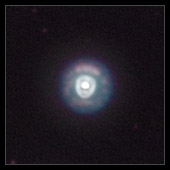 In November 1999 the Hubble Space Telescope suddenly stopped working. Another gyroscope had failed, leaving the telescope with only two working ones—without at least three working gyroscopes, the telescope lost its bearings, unable to tell which way it was pointing. In November 1999 the Hubble Space Telescope suddenly stopped working. Another gyroscope had failed, leaving the telescope with only two working ones—without at least three working gyroscopes, the telescope lost its bearings, unable to tell which way it was pointing.
Fortunately, only a few weeks later, a Space Shuttle orbiter rendezvoused with Hubble and four astronauts repaired the multi-billion dollar telescope in a series of spacewalks. To test out the newly repaired observatory, scientists on Earth commanded it to point to a target and take some pictures. The result was magnificent—the telescope had been fully repaired. And the target that Hubble captured, a bright planetary nebula known as the Eskimo Nebula, was revealed in all its glory.
My shot of the Eskimo Nebula (or NGC 2392) is of course far inferior to Hubble's. Nevertheless, there is something very satisfying in capturing the same object. You don't need a ten billion dollar space program to enjoy the night sky. All you need is some modest equipment, a little luck, and a lot of patience.
The Astrotourist: NGC 2392 |
|
2/1/2009 |
Astronomers love catalogs the way physicists love graph paper and biologists love gooey biological stuff. When I bought my first CCD camera, I didn't need a catalog: My target choices were either the Orion Nebula or the Whirlpool Galaxy. Everything else looked like a brownish blob of varying texture and fuzziness.
Now that cameras (and my skills) have improved, I have more choices. Every month I pore through my catalogs in search of interesting objects that might make good pictures. Last month I wrote down my favorite objects for January. This month I list my favorite objects between 6 and 8 hours of Right Ascension, that is, those objects that happen to be pretty high in the sky at night in February:
| object | type | location | mag | size | skill |
|---|
| NGC 2264 Christmas Tree Cluster | dn | Mon 6H 41.0m +9°54' | 4.4 | 40' × 40' | Beginner |
| NGC 2174 Monkey Head Nebula | dn | Ori 6H 9.7m +20°30' | - | 40' × 40' | Intermediate |
| NGC 2244 Rosette Nebula | dn | Mon 6H 34.4m +4°52' | 4.8 | 80' × 60' | Intermediate |
| NGC 2261 Hubble's Variable Nebula | dn | Mon 6H 39.2m +8°44' | ~10 | 2' × 2' | Intermediate |
| NGC 2359 Thor's Helmet | dn | CMa 7H 18.6m -13°12' | - | 10' × 10' | Intermediate |
| NGC 2392 Eskimo Nebula | pn | Gem 7H 29.2m +20°55' | 10 | 47" × 43" | Intermediate |
| NGC 2403 | sg | Cam 7H 36.9m +65°36' | 8.4 | 29' × 13' | Intermediate | | NGC 2467 (Sharpless 2-331) | dn | Pup 7H 52.6m -26°23' | 7 | 16' × 16' | Intermediate |
| IC 2177 Seagull Nebula | dn | Mon 7H 5.1m -10°42' | - | ~2° × 2° | Advanced |
| NGC 2346 | pn | Mon 7H 9.4m -0°48' | - | 54" × 54" | Advanced |
| NGC 2371 & NGC 2372 | pn | Gem 7H 25.6m +29°29' | 13 | 50" × 90" | Advanced |
| NGC 2440 | pn | Pup 7H 41.9m -18°13' | 11 | 30" × 30" | Advanced |
Read more... |
M78 |
1/23/2009 |
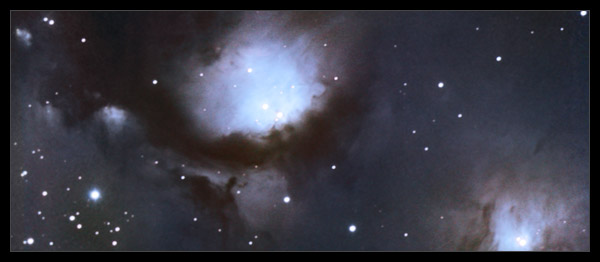
M78 was harder to capture than I expected. The faint nebulae and dark clouds required a lot of exposure time and some aggressive processing.
The Astrotourist: M78 |
M77 |
1/9/2009 |
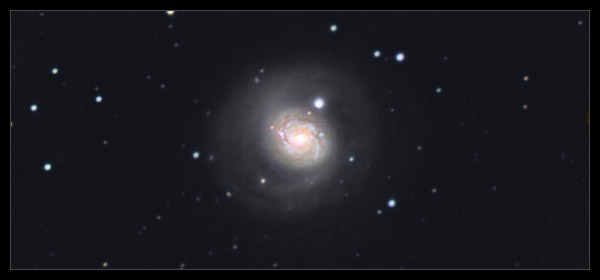
M77 has been badly neglected photographically, at least compared to more popular galaxies like M51 and NGC 891. The Hubble Space Telescope hasn't imaged the whole thing yet, though both Robert Gendler and Russell Croman have (which is almost as good).
One reason for skipping M77 is that it is very difficult to capture. The long exposures required to bring out its faint outer arms often leave its bright central core overexposed. Nevertheless, the results are worth it. I love its tightly wound disk and the contrast with its faint outer arms. It looks a lot like M94, which is another favorite of mine.
The Astrotourist: M77 |
|
1/1/2009 |
With the beginning of the New Year we say goodbye to the galaxies of Andromeda and say hello to the nebulae of Orion. January is the best month to capture the Orion Nebula, the most famous nebula in the sky and probably the easiest deep space object to photograph. But there are many other nebulous objects to capture this month.
These are some of my favorites:
| object | type | location | mag | size | skill |
|---|
| M1 Crab Nebula | sn | Tau 5H 34.5m +22°01' | 8.4 | 6' × 4' | Beginner |
| M42 Orion Nebula | dn | Ori 5H 35.3m -5°23' | 3.7 | 90' × 60' | Beginner |
| NGC 1977 Running Man | dn | Ori 5H 35.5m -4°52' | 6.3 | 20' × 10' | Beginner |
| Horsehead Nebula | dn | Ori 5H 41.0m -2°27' | - | 6' × 4' | Intermediate |
| IC 405 Flaming Star Nebula | dn | Aur 5H 16.2m +34°16' | 9.2 | 30' × 20' | Intermediate |
| M78 | dn | Ori 5H 46.7m +0°03' | 8.0 | 8' × 6' | Intermediate |
| NGC 1499 California Nebula | dn | Per 4H 03.3m +36°25' | 6.0 | ~3° × 1° | Intermediate |
| NGC 1999 | dn | Ori 5H 36.5m -6°42' | 9.5 | 2' × 2' | Intermediate |
| NGC 2024 Flame Nebula | dn | Ori 5H 41.9m -1°51' | 7.2 | 30' × 30' | Intermediate |
| IC 418 | pn | Lep 5H 27.5m -12°42' | 9.1 | 14" × 11" | Advanced |
| IC 2118 Witch Head Nebula | dn | Ori 5H 02.0m -7°54' | - | ~3° × 1° | Advanced |
| NGC 1501 | pn | Cam 4H 07.0m +60°55' | 10.6 | 56" × 48" | Advanced |
| NGC 1535 | pn | Eri 4H 14.3m -12°44' | 9.1 | 48" × 42" | Advanced | | Simeis 147 | sn | Tau 5H 39.1m +28°00' | - | ~3° × 3° | Advanced |
Read more... |
|
12/9/2008 |
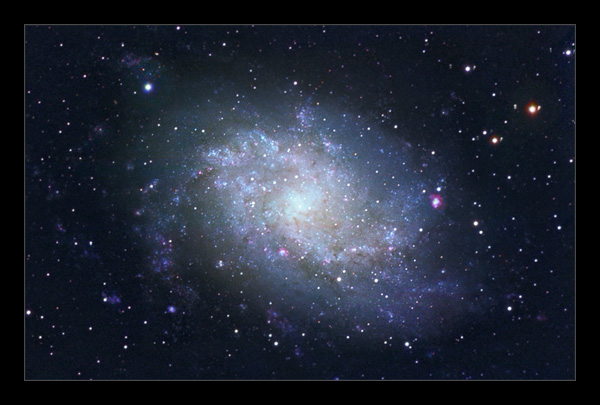
I wasn't always a fan of M33. Its ragged, messy arms are less photogenic than the classic spirals of M51 and M81. But what M33 lacks in grand pattern it more than makes up in detail.
The Astrotourist: M33 |
|
11/16/2008 |
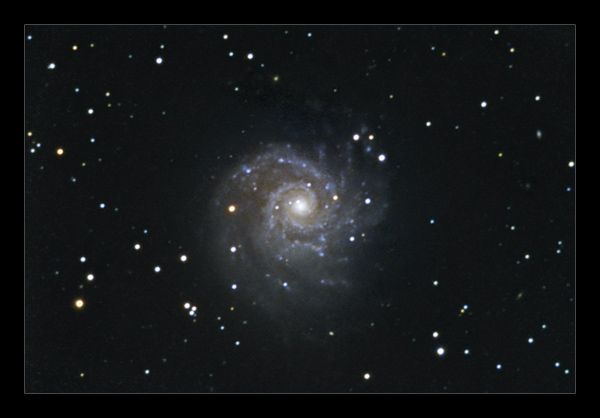
I finally got a chance to take some pictures from the dark skies of the West Coast. This shot of M74 required more than seven hours of exposures.
The Astrotourist: M74 |
|
9/6/2008 |
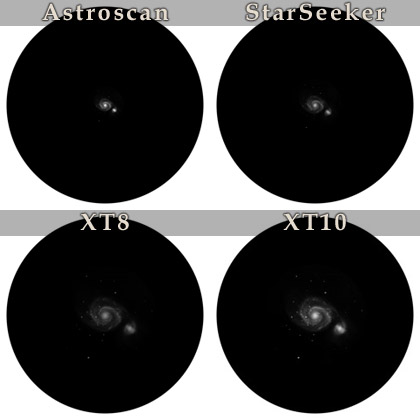
Looking at the sky through a telescope is a lot like reading—you need to use your imagination to complete the picture. That bright pale orb? That’s the planet Jupiter, large enough to swallow a dozen Earths and home to the largest hurricane in the solar system. That ghostly smoke ring? That’s a star exploding—a cataclysm that must have destroyed its planets and that awaits us in less than a billion years. And that fuzzy patch of oval light? Yes, that patch of light is a galaxy!
Nothing in the sky stretches our mind quite like a galaxy. A hundred-thousand light-years across, yet so far away that all we see is a smudge. Its billions of stars spin silently away, out of sight and out of mind to approximately 100% of the world’s population. Seeing a galaxy is the closest we will ever get to grasping the vastness of the universe.
So how can I see a galaxy?
More... |
|
11/23/2007 |
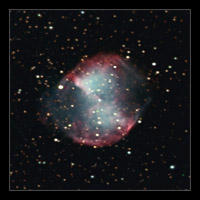 M27 was once a red giant star that ran out of fuel. The core of the star collapsed into a white dwarf, while the outer layers of the star blew out into space. M27 was once a red giant star that ran out of fuel. The core of the star collapsed into a white dwarf, while the outer layers of the star blew out into space.
I took this image more than a year ago, but I didn't have a chance to process it until now.
The Astrotourist: M27
|
|
11/16/2007 |
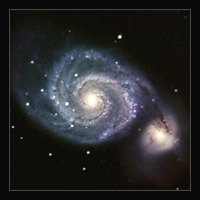 M51 is a pleasure to process. It is bright enough and has enough detail that you can push the contrast and the sharpness pretty far. M51 is a pleasure to process. It is bright enough and has enough detail that you can push the contrast and the sharpness pretty far.
I recently reprocessed an image of M51 that I took back in February 2006. I have learned a lot more about processing since then, and I think the new version is a significant improvement.
The Astrotourist: M51 |
|
2/15/2007 |
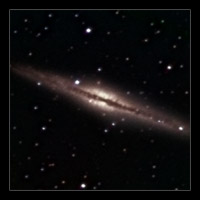 NGC 891 is one of the best edge-on galaxies in the sky and the first galaxy that I captured. Though this image is far from perfect, it is much better than my previous attempt. NGC 891 is one of the best edge-on galaxies in the sky and the first galaxy that I captured. Though this image is far from perfect, it is much better than my previous attempt.
The Astrotourist: NGC 891 |
|
2/2/2007 |

The image on the left was taken with the Meade DSI in December 2004. The image on the right was taken last week with the Meade DSI Pro II.
More... |
|
10/23/2006 |
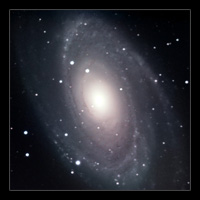 There are very few galaxies in the sky that are better than M81 for astrophotographers. Its beautiful spiral arms are more interesting than those of the brighter (and much larger) M31. And M81 is larger and brighter than M51. On those cold, wintry Northern Hemisphere nights, be sure to give this galaxy its due. There are very few galaxies in the sky that are better than M81 for astrophotographers. Its beautiful spiral arms are more interesting than those of the brighter (and much larger) M31. And M81 is larger and brighter than M51. On those cold, wintry Northern Hemisphere nights, be sure to give this galaxy its due.
The Astrotourist: M81 |
|
10/21/2006 |
 I wrote Penumbra to help me process images taken with the Meade Deep Sky Imager. With Penumbra you can stack FITS files created by the DSI and output 16-bit per channel TIFF files for further processing in Adobe Photoshop or any other image enhancement program. I wrote Penumbra to help me process images taken with the Meade Deep Sky Imager. With Penumbra you can stack FITS files created by the DSI and output 16-bit per channel TIFF files for further processing in Adobe Photoshop or any other image enhancement program.
More...
|
|
2/27/2006 |
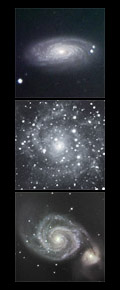 Between the perpetually overcast skies and the light-polution of downtown Seattle, I have not had any chances to look at the sky—nevermind take pictures. Fortunately, a quick trip back to Cambridge satiated my astrophotographical itch. The crisp, clear New England winter skies are no match for Arizona's dry desert skies, but they've got Seattle's beat. In four long nights in Cambridge, I was able to capture three spiral galaxies. Between the perpetually overcast skies and the light-polution of downtown Seattle, I have not had any chances to look at the sky—nevermind take pictures. Fortunately, a quick trip back to Cambridge satiated my astrophotographical itch. The crisp, clear New England winter skies are no match for Arizona's dry desert skies, but they've got Seattle's beat. In four long nights in Cambridge, I was able to capture three spiral galaxies.
More... |
|
5/5/2005 |
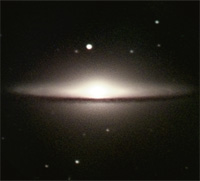 Fans of Transcendence may recognize this galaxy as the one that appears on the title screen. Fans of Transcendence may recognize this galaxy as the one that appears on the title screen.
The dark central dust lane gives this beautiful galaxy a three-dimensional appearance. This is my favorite edge-on galaxy, but its small size and overwhealmingly bright core make it a very challenging object to capture with the DSI.
The Astrotourist: M104 |
|
2/27/2005 |
 Visually, M106 is a very challenging object but don't let that stop you from photographing it. The detail that is so difficult to detect at the eyepiece is glaringly obvious in long-exposure photographs. Unlike the beautiful patterns of M63, however, the detail in M106 is more chaotic and asymmetric. I confess that it took me a while to appreciate its charm, but suspect that this will be an object that I will return to again and again. Visually, M106 is a very challenging object but don't let that stop you from photographing it. The detail that is so difficult to detect at the eyepiece is glaringly obvious in long-exposure photographs. Unlike the beautiful patterns of M63, however, the detail in M106 is more chaotic and asymmetric. I confess that it took me a while to appreciate its charm, but suspect that this will be an object that I will return to again and again.
The Astrotourist: M106 |
|
2/25/2005 |
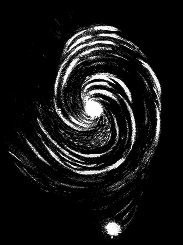 In 1845, the Earl of Rosse first saw the mysterious spiral structure of M51, using a 72-inch reflector, then the world's largest telescope. Today, it is difficult, but not impossible, to see the spiral structure with modest amateur instruments. From under the light-pollution of Cambridge, I have never been able to see any structure at all in M51. Fortunately, a CCD camera can integrate hours worth of light and easily reveal the structure that used to require a telescope the size of a barn to see. In 1845, the Earl of Rosse first saw the mysterious spiral structure of M51, using a 72-inch reflector, then the world's largest telescope. Today, it is difficult, but not impossible, to see the spiral structure with modest amateur instruments. From under the light-pollution of Cambridge, I have never been able to see any structure at all in M51. Fortunately, a CCD camera can integrate hours worth of light and easily reveal the structure that used to require a telescope the size of a barn to see.
The Astrotourist: M51 |
|
2/19/2005 |
 The latest entry in The Astrotourist is M94, the Croc's Eye Galaxy. This is the longest single exposure I've done so far (four hours), and also one of the easiest to process. The latest entry in The Astrotourist is M94, the Croc's Eye Galaxy. This is the longest single exposure I've done so far (four hours), and also one of the easiest to process.
The Astrotourist: M94 |
|
1/19/2005 |
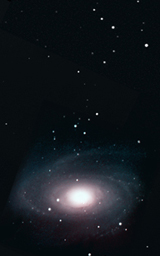 Today, anyone with a modest telescope can easily see the fuzzy patches of light from these two galaxies. So why did it take a hundred years for them to be discovered? As with so many things in life, it's easy to find something if you know where to look. In 1774, before telescope go-to computers, before "Sky Atlas 2000.0" and even before "Astronomy for Dummies," finding a deep sky object was strictly trial and error. More... Today, anyone with a modest telescope can easily see the fuzzy patches of light from these two galaxies. So why did it take a hundred years for them to be discovered? As with so many things in life, it's easy to find something if you know where to look. In 1774, before telescope go-to computers, before "Sky Atlas 2000.0" and even before "Astronomy for Dummies," finding a deep sky object was strictly trial and error. More... |
|
1/12/2005 |
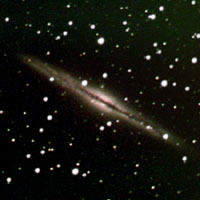 The Milky Way might look like this if viewed edge-on by someone 30 million light-years away. The Milky Way might look like this if viewed edge-on by someone 30 million light-years away.
The central bulge is the core of the galaxy, where (very likely) a massive black hole is gorging itself on star systems and belching out X-rays and gamma-rays. The dark band across the middle is a dust lane along one of the galaxy's arms. If this were our galaxy, the solar system would be two-thirds of the way from the central bulge to the edge of the galaxy. More... |
|
12/22/2004 |
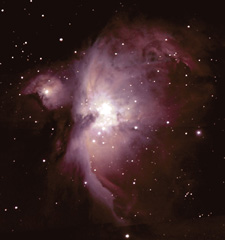 What would the Orion Nebula look like if we could see it up close? Probably nothing like the image above. The human eye is probably not sensitive enough to see M42's winged mantle of nebulosity, even if we got a lot closer. The nebula would get brighter as we got closer, but since it would also get larger, its light would be spread out over a larger area and would be just as hard to see. Most likely, any future astronaut-tourists would just see the central core of the nebula, where newborn stars have carved out a diaphanous web of illuminated gasses. More... What would the Orion Nebula look like if we could see it up close? Probably nothing like the image above. The human eye is probably not sensitive enough to see M42's winged mantle of nebulosity, even if we got a lot closer. The nebula would get brighter as we got closer, but since it would also get larger, its light would be spread out over a larger area and would be just as hard to see. Most likely, any future astronaut-tourists would just see the central core of the nebula, where newborn stars have carved out a diaphanous web of illuminated gasses. More... |
|
12/18/2004 |
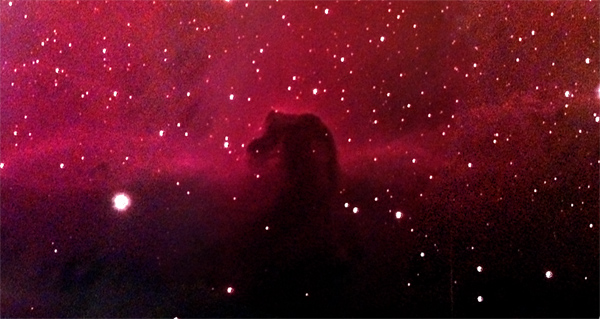
In some alternate timeline in which the descendants of horses, rather than of monkeys, evolved into telescope-wielding beings, perhaps fringe groups of conspiracy-lovers might look at this picture and believe that super-intelligent, alien horses created this stellar monument. Instead, in our timeline, conspiracy-lovers are more interested in a different picture.
More... |
|
12/17/2004 |
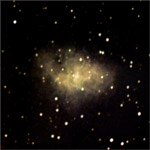 On a summer day in A.D. 1054, Chinese astronomers looked up at the sky and saw a new star. At first, it was brighter than the planet Venus and visible even in daylight, but month after month the “guest star” dimmed until it finally faded beyond their power to see. Almost a thousand years later I captured the image that you see above. Now known as the Crab Nebula, it is all that remains of the brilliant explosion that the Chinese astronomers saw, visible to me now only by using a telescope, a digital camera, and a personal computer. More... On a summer day in A.D. 1054, Chinese astronomers looked up at the sky and saw a new star. At first, it was brighter than the planet Venus and visible even in daylight, but month after month the “guest star” dimmed until it finally faded beyond their power to see. Almost a thousand years later I captured the image that you see above. Now known as the Crab Nebula, it is all that remains of the brilliant explosion that the Chinese astronomers saw, visible to me now only by using a telescope, a digital camera, and a personal computer. More... |
|
11/23/2004 |
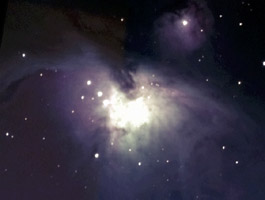 Even with the naked eye, the Orion Nebula is visible as a fuzzy patch of light in the center of Orion's sword. The nebula is a young star-forming region only 1,600 light-years away. Entire star systems are being born and the light from the new-born stars illuminates the cocoon of gas that surrounds them and from which they came. Perhaps our solar system was born in such a place. More... Even with the naked eye, the Orion Nebula is visible as a fuzzy patch of light in the center of Orion's sword. The nebula is a young star-forming region only 1,600 light-years away. Entire star systems are being born and the light from the new-born stars illuminates the cocoon of gas that surrounds them and from which they came. Perhaps our solar system was born in such a place. More... |
|
11/19/2004 |
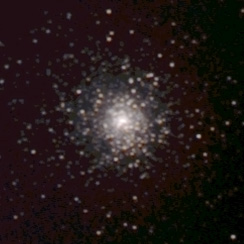 M15 is a globular cluster in the constellation Pegasus. It is not quite as large or as bright as M13, the Great Hercules Cluster and not nearly as impressive as Omega Centauri (at least, that's what I've read—Omega Centauri is only visible from the Southern Hemisphere). Nevertheless, M15 is an easy telescopic destination and one of the best Autumn deep-sky objects. More... M15 is a globular cluster in the constellation Pegasus. It is not quite as large or as bright as M13, the Great Hercules Cluster and not nearly as impressive as Omega Centauri (at least, that's what I've read—Omega Centauri is only visible from the Southern Hemisphere). Nevertheless, M15 is an easy telescopic destination and one of the best Autumn deep-sky objects. More... |
|
11/19/2004 |
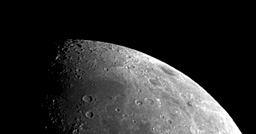 The new Meade Deep Sky Imager (DSI) is an entry-level CCD camera designed for beginner and intermediate digital astrophotographers. When combined with a fast (f/4) Newtonian like the 8" LXD75, the DSI is capable of some decent images. Of course, they can't compare to the pictures streaming out of a fat SBIG chip looking down the barrel of a Takahashi apo, but for that kind of money, I'd rather rent time on Hubble. More... The new Meade Deep Sky Imager (DSI) is an entry-level CCD camera designed for beginner and intermediate digital astrophotographers. When combined with a fast (f/4) Newtonian like the 8" LXD75, the DSI is capable of some decent images. Of course, they can't compare to the pictures streaming out of a fat SBIG chip looking down the barrel of a Takahashi apo, but for that kind of money, I'd rather rent time on Hubble. More... |
|
8/26/2004 |
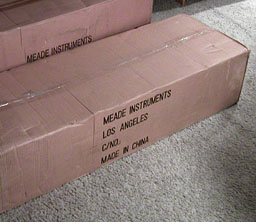 The first lesson of amateur astronomy is patience. Most of the time we wait for the weather--a month of muggy New England days can seems like a million years to an amateur astronomer waiting for a dark and crisp fall night. And then there's waiting for UPS. Fortunately for me, only a month and 117 days after ordering a new 8" Meade LXD75 Schmidt-Newtonian telescope, I signed for two boxes bearing those magic phrases: "MEADE INSTRUMENTS" and "MADE IN CHINA". Yes, my telescope had arrived. More... The first lesson of amateur astronomy is patience. Most of the time we wait for the weather--a month of muggy New England days can seems like a million years to an amateur astronomer waiting for a dark and crisp fall night. And then there's waiting for UPS. Fortunately for me, only a month and 117 days after ordering a new 8" Meade LXD75 Schmidt-Newtonian telescope, I signed for two boxes bearing those magic phrases: "MEADE INSTRUMENTS" and "MADE IN CHINA". Yes, my telescope had arrived. More... |
|
6/27/2004 |
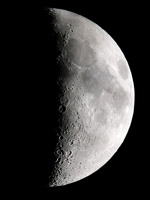 The magnificent desolation of the lunar surface is visible even through a small telescope. I created this image by stitching together eight separate close-up pictures. I took each picture with an Olympus D-40z digital camera looking through an 8" Schmidt-Cassegrain telescope. Then I arranged the pictures into a mosaic in Adobe Photoshop. The resulting image was 25 megapixels, but I've scaled it down for the web. The magnificent desolation of the lunar surface is visible even through a small telescope. I created this image by stitching together eight separate close-up pictures. I took each picture with an Olympus D-40z digital camera looking through an 8" Schmidt-Cassegrain telescope. Then I arranged the pictures into a mosaic in Adobe Photoshop. The resulting image was 25 megapixels, but I've scaled it down for the web. |
|
6/8/2004 |
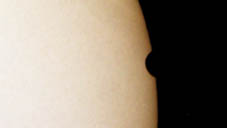 The secret to amateur astronomy is to manage your expectations. The Whirlpool Galaxy in the eyepiece? Don't expect more than a glowing smudge. The greatest comet since Halley's? Don't bet on it. The first transit of Venus in 122 years? It will probably be cloudy. More... The secret to amateur astronomy is to manage your expectations. The Whirlpool Galaxy in the eyepiece? Don't expect more than a glowing smudge. The greatest comet since Halley's? Don't bet on it. The first transit of Venus in 122 years? It will probably be cloudy. More... |
|
3/14/2004 |
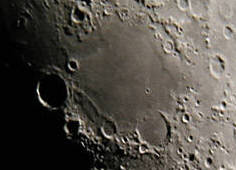 I take the moon for granted sometimes. I spend hours trying to take a picture of Mars or Saturn and end up with nothing more than a blurry disk a few hundred pixels across. My 4 megapixel camera ends up using 3.9 million pixels to record the color of deep black space. It's almost enough to make me give up astrophotography and take up a more rewarding hobby—maybe building perpetual motion machines would be less frustrating. But then I remember: The moon! More... I take the moon for granted sometimes. I spend hours trying to take a picture of Mars or Saturn and end up with nothing more than a blurry disk a few hundred pixels across. My 4 megapixel camera ends up using 3.9 million pixels to record the color of deep black space. It's almost enough to make me give up astrophotography and take up a more rewarding hobby—maybe building perpetual motion machines would be less frustrating. But then I remember: The moon! More... |
|
2/16/2004 |
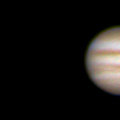 On any clear night you can look out into space and see the other planets that share our little Solar System. You don't need any special equipment—five planets are visible to the naked eye—all you need is the knowledge of how to recognize a planet when you see one. More... On any clear night you can look out into space and see the other planets that share our little Solar System. You don't need any special equipment—five planets are visible to the naked eye—all you need is the knowledge of how to recognize a planet when you see one. More... |
|
12/29/2003 |
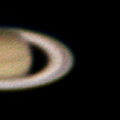 I took some pictures of Saturn on Sunday. The result is not impressive, even by the standards of amateur astronomy, but it's the best image of Saturn that I've made. More... I took some pictures of Saturn on Sunday. The result is not impressive, even by the standards of amateur astronomy, but it's the best image of Saturn that I've made. More... |
|
11/8/2003 |

I've never been interested in lunar eclipses. Even a partial solar eclipse can be an unforgettable event, and watching a total eclipse of the sun can count as one of life's most amazing experiences. But for some reason I have never been able to get too excited about a lunar eclipse. The moon starts getting dark. Then it turns sort of reddish. Then it starts getting bright again. Whatever. More... |
|
9/20/2003 |
 Mars from Cambridge, MA through a 20 centimeter (8") Meade SCT. Mars from Cambridge, MA through a 20 centimeter (8") Meade SCT. |
|
By George Moromisato
Dedicated to the art of hacking your neural patterns to match mine
Information and downloads related to the classic 80's game of galactic conquest
Images of the stars and planets
Touring the universe and returning with pictures
Review of books, movies, games, etc.
A resident's guide to planet Earth
Posts and images related to computer graphics
Notes and articles about Kronosaur Productions
Digital image creation software
Astronomical image manipulation software
Touring the world with a digital camera
Notes on computers and software
Words and pictures about all things technological
A game of space combat and adventure in a large and detailed universe
Copyright © 1999-2013
by George Moromisato
All Rights Reserved |
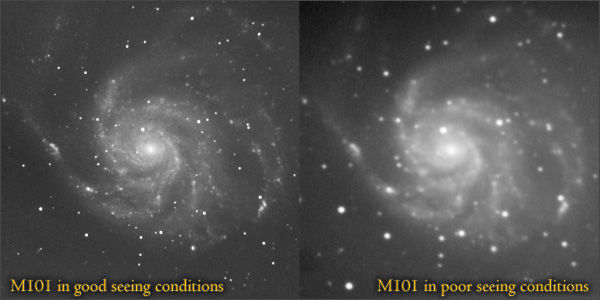
 Today, anyone with a modest telescope can easily see the fuzzy patches of light from these two galaxies. So why did it take a hundred years for them to be discovered? As with so many things in life, it's easy to find something if you know where to look. In 1774, before telescope go-to computers, before "Sky Atlas 2000.0" and even before "Astronomy for Dummies," finding a deep sky object was strictly trial and error. More...
Today, anyone with a modest telescope can easily see the fuzzy patches of light from these two galaxies. So why did it take a hundred years for them to be discovered? As with so many things in life, it's easy to find something if you know where to look. In 1774, before telescope go-to computers, before "Sky Atlas 2000.0" and even before "Astronomy for Dummies," finding a deep sky object was strictly trial and error. More... What would the Orion Nebula look like if we could see it up close? Probably nothing like the image above. The human eye is probably not sensitive enough to see M42's winged mantle of nebulosity, even if we got a lot closer. The nebula would get brighter as we got closer, but since it would also get larger, its light would be spread out over a larger area and would be just as hard to see. Most likely, any future astronaut-tourists would just see the central core of the nebula, where newborn stars have carved out a diaphanous web of illuminated gasses. More...
What would the Orion Nebula look like if we could see it up close? Probably nothing like the image above. The human eye is probably not sensitive enough to see M42's winged mantle of nebulosity, even if we got a lot closer. The nebula would get brighter as we got closer, but since it would also get larger, its light would be spread out over a larger area and would be just as hard to see. Most likely, any future astronaut-tourists would just see the central core of the nebula, where newborn stars have carved out a diaphanous web of illuminated gasses. More... On a summer day in A.D. 1054, Chinese astronomers looked up at the sky and saw a new star. At first, it was brighter than the planet Venus and visible even in daylight, but month after month the “guest star” dimmed until it finally faded beyond their power to see. Almost a thousand years later I captured the image that you see above. Now known as the Crab Nebula, it is all that remains of the brilliant explosion that the Chinese astronomers saw, visible to me now only by using a telescope, a digital camera, and a personal computer. More...
On a summer day in A.D. 1054, Chinese astronomers looked up at the sky and saw a new star. At first, it was brighter than the planet Venus and visible even in daylight, but month after month the “guest star” dimmed until it finally faded beyond their power to see. Almost a thousand years later I captured the image that you see above. Now known as the Crab Nebula, it is all that remains of the brilliant explosion that the Chinese astronomers saw, visible to me now only by using a telescope, a digital camera, and a personal computer. More... Even with the naked eye, the Orion Nebula is visible as a fuzzy patch of light in the center of Orion's sword. The nebula is a young star-forming region only 1,600 light-years away. Entire star systems are being born and the light from the new-born stars illuminates the cocoon of gas that surrounds them and from which they came. Perhaps our solar system was born in such a place. More...
Even with the naked eye, the Orion Nebula is visible as a fuzzy patch of light in the center of Orion's sword. The nebula is a young star-forming region only 1,600 light-years away. Entire star systems are being born and the light from the new-born stars illuminates the cocoon of gas that surrounds them and from which they came. Perhaps our solar system was born in such a place. More... M15 is a globular cluster in the constellation Pegasus. It is not quite as large or as bright as M13, the Great Hercules Cluster and not nearly as impressive as Omega Centauri (at least, that's what I've read—Omega Centauri is only visible from the Southern Hemisphere). Nevertheless, M15 is an easy telescopic destination and one of the best Autumn deep-sky objects. More...
M15 is a globular cluster in the constellation Pegasus. It is not quite as large or as bright as M13, the Great Hercules Cluster and not nearly as impressive as Omega Centauri (at least, that's what I've read—Omega Centauri is only visible from the Southern Hemisphere). Nevertheless, M15 is an easy telescopic destination and one of the best Autumn deep-sky objects. More... The new Meade Deep Sky Imager (DSI) is an entry-level CCD camera designed for beginner and intermediate digital astrophotographers. When combined with a fast (f/4) Newtonian like the 8" LXD75, the DSI is capable of some decent images. Of course, they can't compare to the pictures streaming out of a fat SBIG chip looking down the barrel of a Takahashi apo, but for that kind of money, I'd rather rent time on Hubble. More...
The new Meade Deep Sky Imager (DSI) is an entry-level CCD camera designed for beginner and intermediate digital astrophotographers. When combined with a fast (f/4) Newtonian like the 8" LXD75, the DSI is capable of some decent images. Of course, they can't compare to the pictures streaming out of a fat SBIG chip looking down the barrel of a Takahashi apo, but for that kind of money, I'd rather rent time on Hubble. More... The first lesson of amateur astronomy is patience. Most of the time we wait for the weather--a month of muggy New England days can seems like a million years to an amateur astronomer waiting for a dark and crisp fall night. And then there's waiting for UPS. Fortunately for me, only a month and 117 days after ordering a new 8" Meade LXD75 Schmidt-Newtonian telescope, I signed for two boxes bearing those magic phrases: "MEADE INSTRUMENTS" and "MADE IN CHINA". Yes, my telescope had arrived. More...
The first lesson of amateur astronomy is patience. Most of the time we wait for the weather--a month of muggy New England days can seems like a million years to an amateur astronomer waiting for a dark and crisp fall night. And then there's waiting for UPS. Fortunately for me, only a month and 117 days after ordering a new 8" Meade LXD75 Schmidt-Newtonian telescope, I signed for two boxes bearing those magic phrases: "MEADE INSTRUMENTS" and "MADE IN CHINA". Yes, my telescope had arrived. More... The magnificent desolation of the lunar surface is visible even through a small telescope. I created this image by stitching together eight separate close-up pictures. I took each picture with an Olympus D-40z digital camera looking through an 8" Schmidt-Cassegrain telescope. Then I arranged the pictures into a mosaic in Adobe Photoshop. The resulting image was 25 megapixels, but I've scaled it down for the web.
The magnificent desolation of the lunar surface is visible even through a small telescope. I created this image by stitching together eight separate close-up pictures. I took each picture with an Olympus D-40z digital camera looking through an 8" Schmidt-Cassegrain telescope. Then I arranged the pictures into a mosaic in Adobe Photoshop. The resulting image was 25 megapixels, but I've scaled it down for the web. The secret to amateur astronomy is to manage your expectations. The Whirlpool Galaxy in the eyepiece? Don't expect more than a glowing smudge. The greatest comet since Halley's? Don't bet on it. The first transit of Venus in 122 years? It will probably be cloudy. More...
The secret to amateur astronomy is to manage your expectations. The Whirlpool Galaxy in the eyepiece? Don't expect more than a glowing smudge. The greatest comet since Halley's? Don't bet on it. The first transit of Venus in 122 years? It will probably be cloudy. More... I take the moon for granted sometimes. I spend hours trying to take a picture of Mars or Saturn and end up with nothing more than a blurry disk a few hundred pixels across. My 4 megapixel camera ends up using 3.9 million pixels to record the color of deep black space. It's almost enough to make me give up astrophotography and take up a more rewarding hobby—maybe building perpetual motion machines would be less frustrating. But then I remember: The moon! More...
I take the moon for granted sometimes. I spend hours trying to take a picture of Mars or Saturn and end up with nothing more than a blurry disk a few hundred pixels across. My 4 megapixel camera ends up using 3.9 million pixels to record the color of deep black space. It's almost enough to make me give up astrophotography and take up a more rewarding hobby—maybe building perpetual motion machines would be less frustrating. But then I remember: The moon! More... On any clear night you can look out into space and see the other planets that share our little Solar System. You don't need any special equipment—five planets are visible to the naked eye—all you need is the knowledge of how to recognize a planet when you see one. More...
On any clear night you can look out into space and see the other planets that share our little Solar System. You don't need any special equipment—five planets are visible to the naked eye—all you need is the knowledge of how to recognize a planet when you see one. More... I took some pictures of Saturn on Sunday. The result is not impressive, even by the standards of amateur astronomy, but it's the best image of Saturn that I've made. More...
I took some pictures of Saturn on Sunday. The result is not impressive, even by the standards of amateur astronomy, but it's the best image of Saturn that I've made. More... Mars from Cambridge, MA through a 20 centimeter (8") Meade SCT.
Mars from Cambridge, MA through a 20 centimeter (8") Meade SCT.



